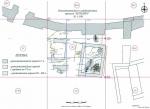Summary (English)
HOTALICH FORTRESS (Nadezhda Boteva – nadejda_boteva@abv.bg) Houses Nos. 1 and 2 of the 6th century AD were explored. The fortification wall in that area was built at the end of the 5th century AD. House No. 2 was built of roughly-cut stones bonded with clay. Early Byzantine sherds were found. House No. 1 measured 5 m by 7 m. Its walls were 75 – 80 cm wide, built of roughly-cut stones bonded with clay. A pavement of stone slabs was documented and a hearth constructed of stones was discovered. The finds included Early Byzantine sherds, a lead spindle whorl, a bronze fibula and a coin of 40 nummi of Justinian I minted in AD 549 – 550 in Constantinople. Two Christian burials of the end of the 5th century AD were discovered under the floor of the house. The dead were young individuals, one of them with two copper bracelets on her hands. House No. 1 also functioned as a workshop for producing bone objects. Eleven objects were found, produced mostly from antler, some of them finished, others not, including two handles with geometric decoration, five spindle whorls and three combs. During the 10th – 12th centuries, the two houses were reoccupied.
- Nadezhda Boteva - Museum of History – Sevlievo
Director
Team
Research Body
- Museum of History – Sevlievo






![Download [PDF]](/excavation/skins/fasti/images/results/download_sml.png)
